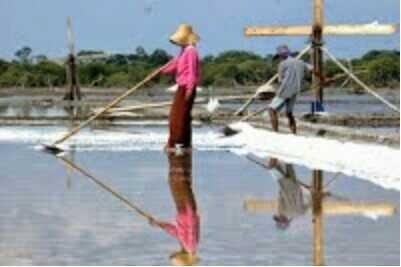Traditional salt making
Salt is a very important commodity for the life of our society, just imagine if no salt will be tasteless feels our life as the saying goes. salt can not only be consumed but salt can also be categorized in industrial materials, such as leather tanning industry, offshore oil drilling etc. the process of making salt is traditionally arguably there are two types namely by the method of evaporation with sunlight in ponds - salt ponds and by boiling technique (boiled salt) .
Usually salt farmers make salt by means of plots for evaporation, to get good salt yields with large crystals, salt farmers usually directly vaporize seawater that flows on plots. the process of making salt by means of evaporation of sunlight is called crystallization (evaporation) is a way of separating the mixture / solute from the solvent by heating or absorption of heat based on the boiling point. water has a lower boiling point than salt, so when the sea water is exposed to the sun's heat, the water will evaporate leaving the salt particles and then form salt crystals. it is these crystals which are then collected by salt farmers to be washed thoroughly and dried again to produce a proper salt
Sea water
Sea water quality (especially in terms of its salinity (including contamination with river water), greatly affects the time needed for concentration (evaporation).
Weather conditions
The length of the drought affects directly to the "opportunity" given to us to make salt with sunlight.
Rainfall (intensity) and rainfall patterns of distribution in the average year is an indicator that is closely related to the drought that all affect the evaporation of seawater.
Wind speed, air humidity and air temperature greatly affect the speed of water evaporation, where the greater the evaporation the greater the amount of salt crystals that precipitate.
Soil porosity properties affect the rate of seepage (leakage) of sea water into the soil in the peminihan or on the table. When the permeate rate is greater than the rate of evaporation, In salt crystallization the salt water concentration should be between 25-29 ° Be. if the old water concentration has not reached 25 ° Be then the gypsum (Calcium Sulfate) will settle a lot, if the old water concentration more than 29 ° Be Magnesium will be much settled .

http://seputarduniasains.blogspot.co.id